ส่วนประกอบ: แนวคิด
จัดทุกอย่างให้เป็นระเบียบอยู่เสมอด้วยคอลเล็กชัน
บันทึกและจัดหมวดหมู่เนื้อหาตามค่ากำหนดของคุณ
องค์ประกอบ: แนวคิด / ข้อมูล
| เนมสเปซ |
http://schemas.google.com/dspl/2010 |
| คำอธิบายประกอบ |
ข้อมูลที่เป็นข้อความ เช่น ชื่อและคำอธิบายของ
แนวคิด |
| แผนภาพ |
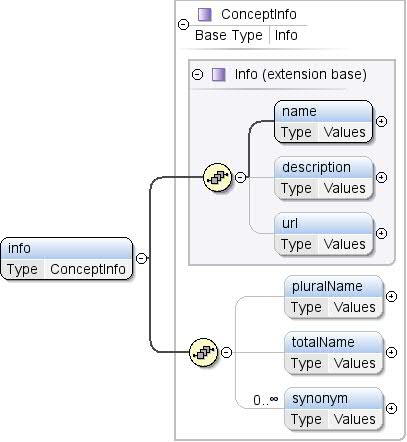 |
| ประเภท |
ConceptInfo |
| ลำดับชั้นของประเภท |
|
| พร็อพเพอร์ตี้ |
|
| รุ่น |
ชื่อ , คำอธิบาย{0,1} , url{0,1} , pluralName{0,1} , totalName{0,1} , คำพ้องความหมาย* |
| เด็ก |
description, name, pluralName,
คำพ้องความหมาย, totalName, url |
| อินสแตนซ์ |
<info>
<name>{1,1}</name>
<description>{0,1}</description>
<url>{0,1}</url>
</info>
|
| แหล่งที่มา |
<xs:element name="info" type="ConceptInfo">
<xs:annotation>
<xs:documentation>Textual information, such as the name and description of
the concept.</xs:documentation>
</xs:annotation>
</xs:element>
|
องค์ประกอบ: แนวคิด / หัวข้อ
| เนมสเปซ |
http://schemas.google.com/dspl/2010 |
| คำอธิบายประกอบ |
หัวข้อที่มีการเชื่อมโยงแนวคิด |
| แผนภาพ |
 |
| พร็อพเพอร์ตี้ |
| เนื้อหา: |
ซับซ้อน |
| ขั้นต่ำ: |
0 |
| maxOccurs: |
ไร้ขอบเขต |
|
| Attributes |
| QName |
ประเภท |
คงที่ |
ค่าเริ่มต้น |
ใช้ |
หมายเหตุ |
| อ้างอิง |
xs:QName |
|
|
ไม่บังคับ |
ตัวระบุที่ไม่ซ้ำกันของหัวข้อแนวคิดนี้
ที่เกี่ยวข้อง หัวข้อที่อ้างอิงอาจกำหนดไว้ในลักษณะเดียวกัน
หรือชุดข้อมูลภายนอก ซึ่งก็คือในชุดข้อมูลอื่น การอ้างอิงถึง
หัวข้อภายนอกต้องอยู่ในรูปแบบ
"prefix:other_topic_id" โดยที่ "prefix" คือ
คำนำหน้าที่ใช้สำหรับเนมสเปซของชุดข้อมูลภายนอก (ดู XML
เนมสเปซ) |
|
| แหล่งที่มา |
<xs:element name="topic" minOccurs="0" maxOccurs="unbounded">
<xs:annotation>
<xs:documentation>A topic the concept is associated with.</xs:documentation>
</xs:annotation>
<xs:complexType>
<xs:attribute name="ref" type="xs:QName">
<xs:annotation>
<xs:documentation>The unique identifier of the topic this concept is
associated with.
The referenced topic may be defined in the same
dataset or externally, i.e., in another dataset. A
reference to an external topic must be of the form
"prefix:other_topic_id", where "prefix" is the prefix
used for the namespace of the external dataset (see
XML namespaces).</xs:documentation>
</xs:annotation>
</xs:attribute>
</xs:complexType>
</xs:element>
|
องค์ประกอบ: แนวคิด / ประเภท
| เนมสเปซ |
http://schemas.google.com/dspl/2010 |
| คำอธิบายประกอบ |
ประเภทข้อมูลของแนวคิด แนวคิดต้องระบุประเภท
การประกาศ หรือขยายแนวคิดอื่น ในกรณีที่
การขยายแนวคิด ยังอาจแสดงการประกาศประเภท ประเภทของ
แนวคิดแบบขยายต้องมีข้อจำกัดน้อยกว่าประเภทของ
เพื่อเพิ่มแนวคิด "จำกัดน้อยกว่า" (LRT) คือ
ระบุลำดับบางส่วนดังนี้: จำนวนเต็ม LRT จำนวนลอยตัว LRT ของสตริง
สตริง LRT สตริงวันที่ LRT บูลีน |
| แผนภาพ |
 |
| พร็อพเพอร์ตี้ |
| เนื้อหา: |
ซับซ้อน |
| ขั้นต่ำ: |
0 |
|
| Attributes |
|
| แหล่งที่มา |
<xs:element name="type" minOccurs="0">
<xs:annotation>
<xs:documentation>The data type of the concept. A concept must provide a type declaration or extend
another concept. In the case where it's extending a concept, it may also
provide a type declaration. The type of the extended concept must be less restrictive
than the type of the concept extending it.
"Less restrictive than" (LRT) is a partial order defined as follows:
string LRT float
float LRT integer
string LRT date
string LRT boolean</xs:documentation>
</xs:annotation>
<xs:complexType>
<xs:attribute name="ref" type="DataType" use="required"/>
</xs:complexType>
</xs:element>
|
องค์ประกอบ: แนวคิด / แอตทริบิวต์
| เนมสเปซ |
http://schemas.google.com/dspl/2010 |
| คำอธิบายประกอบ |
แอตทริบิวต์ของแนวคิด แอตทริบิวต์แสดงถึง
ข้อมูลเกี่ยวกับแนวคิด (เช่น GDP คิดเป็นเปอร์เซ็นต์) |
| แผนภาพ |
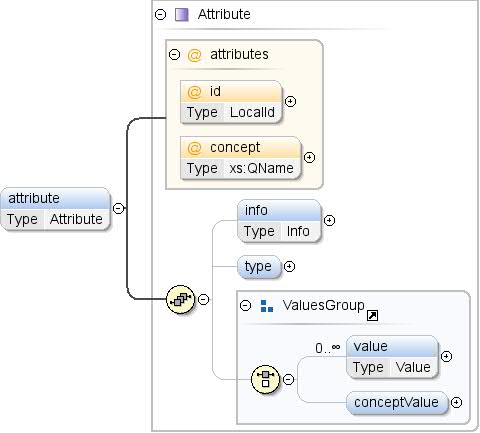 |
| ประเภท |
แอตทริบิวต์ |
| พร็อพเพอร์ตี้ |
| เนื้อหา: |
ซับซ้อน |
| ขั้นต่ำ: |
0 |
| maxOccurs: |
ไร้ขอบเขต |
|
| รุ่น |
info{0,1} , type{0,1} , (ค่า*
| conceptValue{0,1}) |
| เด็ก |
conceptValue, info, type
ค่า |
| อินสแตนซ์ |
<attribute concept="" id="">
<info>{0,1}</info>
<type format="" ref="">{0,1}</type>
</attribute>
|
| Attributes |
| QName |
ประเภท |
คงที่ |
ค่าเริ่มต้น |
ใช้ |
หมายเหตุ |
| แนวคิด |
xs:QName |
|
|
ไม่บังคับ |
การอ้างอิงแนวคิดที่สอดคล้องกับค่าต่างๆ
ของแอตทริบิวต์ หากแอตทริบิวต์ระบุประเภท แล้วประเภท
ต้องตรงกับประเภทของแนวคิดที่อ้างอิง การอ้างอิงถึง
แนวคิดภายนอกต้องอยู่ในรูปแบบ
"prefix:other_concept_id" โดยที่ "คำนำหน้า" เท่ากับ
คำนำหน้าที่ใช้สำหรับเนมสเปซของชุดข้อมูลภายนอก (ดู XML
เนมสเปซ) |
| id |
LocalId |
|
|
ไม่บังคับ |
รหัสของแอตทริบิวต์แนวคิด ตัวระบุนี้ต้องเป็น
ไม่ซ้ำกันภายในแนวคิด (ทั้งแอตทริบิวต์และพร็อพเพอร์ตี้)
อาจละเว้น id ได้หากมีการระบุแอตทริบิวต์แนวคิดไว้ ในนั้น
รหัสคือความเรียบง่ายที่สร้างขึ้นด้วยค่า ชื่อท้องถิ่นของ
แนวคิดที่อ้างอิง เช่น <attribute
concept="unit:currency"/> เทียบเท่ากับ
<attribute id="currency"
concept="unit:currency"/> |
|
| แหล่งที่มา |
<xs:element name="attribute" type="Attribute" minOccurs="0" maxOccurs="unbounded">
<xs:annotation>
<xs:documentation>An attribute of the concept. Attributes represent additional
information about the concept (e.g., GDP is a percentage).</xs:documentation>
</xs:annotation>
</xs:element>
|
องค์ประกอบ: แนวคิด / พร็อพเพอร์ตี้
| เนมสเปซ |
http://schemas.google.com/dspl/2010 |
| คำอธิบายประกอบ |
คุณสมบัติของแนวคิด พร็อพเพอร์ตี้เป็นข้อมูลเพิ่มเติม
ข้อมูลเกี่ยวกับอินสแตนซ์ของแนวคิด (เช่น แนวคิด
"เมือง" อาจมีพร็อพเพอร์ตี้ "country") |
| แผนภาพ |
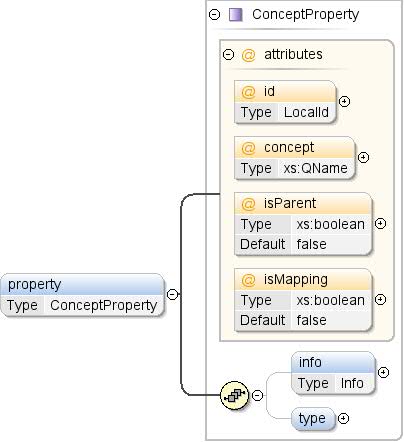 |
| ประเภท |
ConceptProperty |
| พร็อพเพอร์ตี้ |
| เนื้อหา: |
ซับซ้อน |
| ขั้นต่ำ: |
0 |
| maxOccurs: |
ไร้ขอบเขต |
|
| รุ่น |
info{0,1} , ประเภท{0,1} |
| เด็ก |
info, type |
| อินสแตนซ์ |
<property concept="" id="" isMapping="false" isParent="false">
<info>{0,1}</info>
<type ref="">{0,1}</type>
</property>
|
| Attributes |
| QName |
ประเภท |
คงที่ |
ค่าเริ่มต้น |
ใช้ |
หมายเหตุ |
| แนวคิด |
xs:QName |
|
|
ไม่บังคับ |
การอ้างอิงแนวคิดที่สอดคล้องกับค่าต่างๆ
ของพร็อพเพอร์ตี้ หากพร็อพเพอร์ตี้ระบุประเภท ให้กำหนดประเภท
ต้องตรงกับประเภทของแนวคิดที่อ้างอิง การอ้างอิงถึง
แนวคิดภายนอกต้องอยู่ในรูปแบบ
"prefix:other_concept_id" โดยที่ "คำนำหน้า" เท่ากับ
คำนำหน้าที่ใช้สำหรับเนมสเปซของชุดข้อมูลภายนอก (ดู XML
เนมสเปซ) |
| id |
LocalId |
|
|
ไม่บังคับ |
รหัสของพร็อพเพอร์ตี้แนวคิด ตัวระบุนี้ต้องเป็น
ไม่ซ้ำกันภายในแนวคิด (ทั้งแอตทริบิวต์และพร็อพเพอร์ตี้)
ระบบอาจละเว้นรหัสหากระบุพร็อพเพอร์ตี้แนวคิด ในนั้น
รหัสจะถูกสร้างขึ้นโดยปริยายโดยให้ค่ากับชื่อท้องถิ่นของ
แนวคิดที่อ้างอิง ตัวอย่างเช่น <property
concept="geo:country"/> เทียบเท่ากับ <property
id="country"
concept="geo:country"/> |
| isMapping |
xs:boolean |
|
เท็จ |
ไม่บังคับ |
หากเป็นจริง พร็อพเพอร์ตี้นี้ต้องอ้างอิงแนวคิด และ
พร็อพเพอร์ตี้นี้แสดงความสัมพันธ์แบบการแมป (1 ต่อ 1) ระหว่าง
และแนวคิดที่อ้างอิง อินสแตนซ์แต่ละรายการของการอ้างอิง
มีการอ้างอิงแนวคิดมากที่สุดโดย
แนวคิด |
| isParent |
xs:boolean |
|
เท็จ |
ไม่บังคับ |
หากเป็นจริง พร็อพเพอร์ตี้นี้ต้องอ้างอิงแนวคิด และ
พร็อพเพอร์ตี้นี้แสดงถึงความสัมพันธ์ตามลำดับชั้นระหว่าง
และแนวคิดที่อ้างอิง (เช่น ทวีปของ
ประเทศ) |
|
| แหล่งที่มา |
<xs:element name="property" type="ConceptProperty" minOccurs="0" maxOccurs="unbounded">
<xs:annotation>
<xs:documentation>A property of the concept. Properties represent additional
information about instances of the concept (e.g., a concept
"city" may have a property "country").</xs:documentation>
</xs:annotation>
</xs:element>
|
องค์ประกอบ: แนวคิด / defaultValue
| เนมสเปซ |
http://schemas.google.com/dspl/2010 |
| คำอธิบายประกอบ |
ค่าเริ่มต้นสำหรับแนวคิดที่แอปพลิเคชันจะใช้
เมื่อต้องเลือกค่าใดค่าหนึ่งที่เป็นไปได้ของ
แนวคิด |
| แผนภาพ |
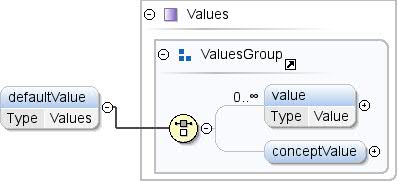 |
| ประเภท |
ค่า |
| พร็อพเพอร์ตี้ |
| เนื้อหา: |
ซับซ้อน |
| ขั้นต่ำ: |
0 |
|
| รุ่น |
มูลค่า* | conceptValue{0,1} |
| เด็ก |
conceptValue, value |
| อินสแตนซ์ |
<defaultValue>
<value lang="">{0,unbounded}</value>
<conceptValue concept="">{0,1}</conceptValue>
</defaultValue>
|
| แหล่งที่มา |
<xs:element name="defaultValue" type="Values" minOccurs="0">
<xs:annotation>
<xs:documentation>A default value for the concept, to be used by
applications when they need to pick one of the possible
values of the concept.</xs:documentation>
</xs:annotation>
</xs:element>
|
องค์ประกอบ: แนวคิด / ตาราง
| เนมสเปซ |
http://schemas.google.com/dspl/2010 |
| คำอธิบายประกอบ |
การอ้างอิงตารางที่มีค่าที่เป็นไปได้ทั้งหมด
สำหรับแนวคิดและสมบัติที่ไม่คงที่ |
| แผนภาพ |
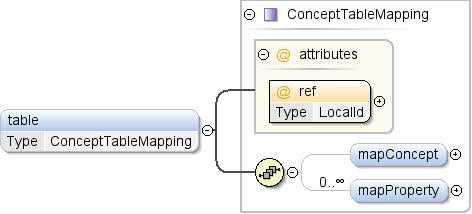 |
| ประเภท |
ConceptTableMapping |
| พร็อพเพอร์ตี้ |
| เนื้อหา: |
ซับซ้อน |
| ขั้นต่ำ: |
0 |
|
| รุ่น |
mapConcept{0,1} , mapProperty* |
| เด็ก |
mapConcept, mapProperty |
| อินสแตนซ์ |
<table ref="">
<mapConcept toColumn="">{0,1}</mapConcept>
<mapProperty lang="" ref="" toColumn="">{0,unbounded}</mapProperty>
</table>
|
| Attributes |
| QName |
ประเภท |
คงที่ |
ค่าเริ่มต้น |
ใช้ |
หมายเหตุ |
| อ้างอิง |
LocalId |
|
|
จำเป็น |
รหัสของตารางที่มีข้อมูลสำหรับ
แนวคิด |
|
| แหล่งที่มา |
<xs:element name="table" type="ConceptTableMapping" minOccurs="0">
<xs:annotation>
<xs:documentation>A reference to a table that contains all the
possible values for the concept and its non-constant
properties.</xs:documentation>
</xs:annotation>
</xs:element>
|
ประเภทที่ซับซ้อน: แนวคิด
| เนมสเปซ |
http://schemas.google.com/dspl/2010 |
| คำอธิบายประกอบ |
แนวคิดคือคำจำกัดความของประเภทข้อมูลที่ปรากฏในส่วน
ชุดข้อมูล (เช่น "GDP" หรือ "อำเภอ") แนวคิดอาจเป็น
เชื่อมโยงกับการแจงนับค่าที่เป็นไปได้ทั้งหมดหรือไม่ ต
อาจมีการอ้างอิงแนวคิดที่กำหนดไว้ในชุดข้อมูลบางรายการใน
ชุดข้อมูล |
| แผนภาพ |
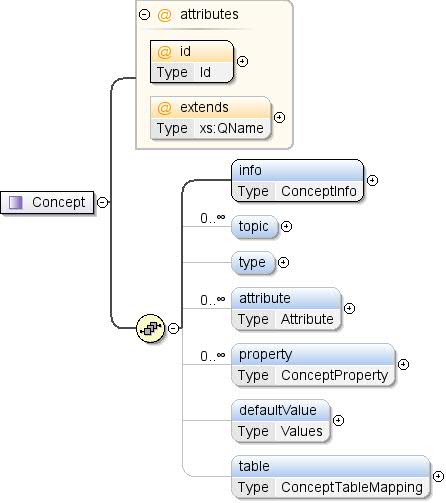 |
| ใช้โดย |
|
| รุ่น |
info , topic* , type{0,1} ,
แอตทริบิวต์* , พร็อพเพอร์ตี้* , defaultValue{0,1} ตาราง{0,1} |
| เด็ก |
attribute, defaultValue, ข้อมูล
พร็อพเพอร์ตี้ ตาราง หัวข้อ
ประเภท |
| Attributes |
| QName |
ประเภท |
คงที่ |
ค่าเริ่มต้น |
ใช้ |
หมายเหตุ |
| ขยาย |
xs:QName |
|
|
ไม่บังคับ |
ตัวระบุที่ไม่ซ้ำของแนวคิดที่แนวคิดนี้
ขยาย ระบบอาจกำหนดแนวคิดที่อ้างอิงในชุดข้อมูลเดียวกัน
หรือภายนอก ซึ่งก็คือชุดข้อมูลอื่น การอ้างอิงไปยังภายนอก
แนวคิดต้องอยู่ในรูปแบบ "prefix:other_concept_id"
โดยที่ "คำนำหน้า" เป็นคำนำหน้าที่ใช้สำหรับเนมสเปซของ
ชุดข้อมูลภายนอก (ดูเนมสเปซ XML) |
| id |
รหัส |
|
|
จำเป็น |
ตัวระบุที่ไม่ซ้ำกันของแนวคิด ซึ่งต้อง
ที่ไม่ซ้ำกันทั่วโลกภายในชุดข้อมูลนี้ |
|
| แหล่งที่มา |
<xs:complexType name="Concept">
<xs:annotation>
<xs:documentation>A concept is a definition of a type of data that appears in the
dataset (e.g., "GDP" or "County"). A concept may be associated with
an enumeration of all its possible values or not. A concept defined in
some dataset may be referenced in other datasets.</xs:documentation>
</xs:annotation>
<xs:sequence>
<xs:element name="info" type="ConceptInfo">
<xs:annotation>
<xs:documentation>Textual information, such as the name and description of
the concept.</xs:documentation>
</xs:annotation>
</xs:element>
<xs:element name="topic" minOccurs="0" maxOccurs="unbounded">
<xs:annotation>
<xs:documentation>A topic the concept is associated with.</xs:documentation>
</xs:annotation>
<xs:complexType>
<xs:attribute name="ref" type="xs:QName">
<xs:annotation>
<xs:documentation>The unique identifier of the topic this concept is
associated with.
The referenced topic may be defined in the same
dataset or externally, i.e., in another dataset. A
reference to an external topic must be of the form
"prefix:other_topic_id", where "prefix" is the prefix
used for the namespace of the external dataset (see
XML namespaces).</xs:documentation>
</xs:annotation>
</xs:attribute>
</xs:complexType>
</xs:element>
<xs:element name="type" minOccurs="0">
<xs:annotation>
<xs:documentation>The data type of the concept. A concept must provide a type declaration or extend
another concept. In the case where it's extending a concept, it may also
provide a type declaration. The type of the extended concept must be less restrictive
than the type of the concept extending it.
"Less restrictive than" (LRT) is a partial order defined as follows:
string LRT float
float LRT integer
string LRT date
string LRT boolean</xs:documentation>
</xs:annotation>
<xs:complexType>
<xs:attribute name="ref" type="DataType" use="required"/>
</xs:complexType>
</xs:element>
<xs:element name="attribute" type="Attribute" minOccurs="0" maxOccurs="unbounded">
<xs:annotation>
<xs:documentation>An attribute of the concept. Attributes represent additional
information about the concept (e.g., GDP is a percentage).</xs:documentation>
</xs:annotation>
</xs:element>
<xs:element name="property" type="ConceptProperty" minOccurs="0" maxOccurs="unbounded">
<xs:annotation>
<xs:documentation>A property of the concept. Properties represent additional
information about instances of the concept (e.g., a concept
"city" may have a property "country").</xs:documentation>
</xs:annotation>
</xs:element>
<xs:element name="defaultValue" type="Values" minOccurs="0">
<xs:annotation>
<xs:documentation>A default value for the concept, to be used by
applications when they need to pick one of the possible
values of the concept.</xs:documentation>
</xs:annotation>
</xs:element>
<xs:element name="table" type="ConceptTableMapping" minOccurs="0">
<xs:annotation>
<xs:documentation>A reference to a table that contains all the
possible values for the concept and its non-constant
properties.</xs:documentation>
</xs:annotation>
</xs:element>
</xs:sequence>
<xs:attribute name="id" type="Id" use="required">
<xs:annotation>
<xs:documentation>The unique identifier of the concept, which must be globally
unique within the dataset.</xs:documentation>
</xs:annotation>
</xs:attribute>
<xs:attribute name="extends" type="xs:QName" use="optional">
<xs:annotation>
<xs:documentation>The unique identifier of a concept that this
concept extends.
The referenced concept may be defined in the same
dataset or externally, i.e., in another dataset. A
reference to an external concept must be of the form
"prefix:other_concept_id", where "prefix" is the
prefix used for the namespace of the external
dataset (see XML namespaces).</xs:documentation>
</xs:annotation>
</xs:attribute>
</xs:complexType>
|
| เนมสเปซ |
ไม่มีเนมสเปซ |
| คำอธิบายประกอบ |
ตัวระบุที่ไม่ซ้ำกันของหัวข้อที่เชื่อมโยงกับแนวคิดนี้
ด้วย ระบบอาจกำหนดหัวข้อที่อ้างอิงในชุดข้อมูลเดียวกัน หรือ
คือภายนอก ซึ่งก็คือชุดข้อมูลอื่น การอ้างอิงหัวข้อภายนอก
ต้องอยู่ในรูปแบบ "คำนำหน้า:other_topic_id" โดยที่
"คำนำหน้า" เป็นคำนำหน้าที่ใช้สำหรับเนมสเปซภายนอก
ชุดข้อมูล (ดูเนมสเปซ XML) |
| ประเภท |
xs:QName |
| พร็อพเพอร์ตี้ |
|
| ใช้โดย |
|
| แหล่งที่มา |
<xs:attribute name="ref" type="xs:QName">
<xs:annotation>
<xs:documentation>The unique identifier of the topic this concept is
associated with.
The referenced topic may be defined in the same
dataset or externally, i.e., in another dataset. A
reference to an external topic must be of the form
"prefix:other_topic_id", where "prefix" is the prefix
used for the namespace of the external dataset (see
XML namespaces).</xs:documentation>
</xs:annotation>
</xs:attribute>
|
| เนมสเปซ |
ไม่มีเนมสเปซ |
| ประเภท |
DataType |
| พร็อพเพอร์ตี้ |
|
| ข้อมูลประกอบ |
| การแจงนับ |
สตริง |
|
| การแจงนับ |
จำนวนลอยตัว |
|
| การแจงนับ |
จำนวนเต็ม |
|
| การแจงนับ |
boolean |
|
| การแจงนับ |
วันที่ |
|
| การแจงนับ |
แนวคิด |
|
|
| ใช้โดย |
|
| แหล่งที่มา |
<xs:attribute name="ref" type="DataType" use="required"/>
|
แอตทริบิวต์: แนวคิด / @id
| เนมสเปซ |
ไม่มีเนมสเปซ |
| คำอธิบายประกอบ |
ตัวระบุที่ไม่ซ้ำกันของแนวคิด ซึ่งต้องใช้ได้ทั่วโลก
ไม่ซ้ำกันภายในชุดข้อมูลนั้น |
| ประเภท |
รหัส |
| พร็อพเพอร์ตี้ |
|
| ข้อมูลประกอบ |
|
| ใช้โดย |
|
| แหล่งที่มา |
<xs:attribute name="id" type="Id" use="required">
<xs:annotation>
<xs:documentation>The unique identifier of the concept, which must be globally
unique within the dataset.</xs:documentation>
</xs:annotation>
</xs:attribute>
|
แอตทริบิวต์: แนวคิด / @extends
| เนมสเปซ |
ไม่มีเนมสเปซ |
| คำอธิบายประกอบ |
ตัวระบุที่ไม่ซ้ำของแนวคิดที่แนวคิดนี้นำมาเพิ่มเติม
แนวคิดที่อ้างอิงอาจกำหนดไว้ในชุดข้อมูลเดียวกันหรือภายนอกก็ได้
นั่นคือ ในชุดข้อมูลอื่น การอ้างอิงไปยังแนวคิดภายนอกจะต้อง
แบบฟอร์ม "prefix:other_concept_id" โดยที่ "คำนำหน้า" เท่ากับ
คำนำหน้าที่ใช้สำหรับเนมสเปซของชุดข้อมูลภายนอก (ดู XML
เนมสเปซ) |
| ประเภท |
xs:QName |
| พร็อพเพอร์ตี้ |
|
| ใช้โดย |
|
| แหล่งที่มา |
<xs:attribute name="extends" type="xs:QName" use="optional">
<xs:annotation>
<xs:documentation>The unique identifier of a concept that this
concept extends.
The referenced concept may be defined in the same
dataset or externally, i.e., in another dataset. A
reference to an external concept must be of the form
"prefix:other_concept_id", where "prefix" is the
prefix used for the namespace of the external
dataset (see XML namespaces).</xs:documentation>
</xs:annotation>
</xs:attribute>
|
สร้างโดยใช้
ตัวแก้ไข XML ของ oXygen
เนื้อหาของหน้าเว็บนี้ได้รับอนุญาตภายใต้ใบอนุญาตที่ต้องระบุที่มาของครีเอทีฟคอมมอนส์ 4.0 และตัวอย่างโค้ดได้รับอนุญาตภายใต้ใบอนุญาต Apache 2.0 เว้นแต่จะระบุไว้เป็นอย่างอื่น โปรดดูรายละเอียดที่นโยบายเว็บไซต์ Google Developers Java เป็นเครื่องหมายการค้าจดทะเบียนของ Oracle และ/หรือบริษัทในเครือ
อัปเดตล่าสุด 2025-07-25 UTC
[[["เข้าใจง่าย","easyToUnderstand","thumb-up"],["แก้ปัญหาของฉันได้","solvedMyProblem","thumb-up"],["อื่นๆ","otherUp","thumb-up"]],[["ไม่มีข้อมูลที่ฉันต้องการ","missingTheInformationINeed","thumb-down"],["ซับซ้อนเกินไป/มีหลายขั้นตอนมากเกินไป","tooComplicatedTooManySteps","thumb-down"],["ล้าสมัย","outOfDate","thumb-down"],["ปัญหาเกี่ยวกับการแปล","translationIssue","thumb-down"],["ตัวอย่าง/ปัญหาเกี่ยวกับโค้ด","samplesCodeIssue","thumb-down"],["อื่นๆ","otherDown","thumb-down"]],["อัปเดตล่าสุด 2025-07-25 UTC"],[],["Concepts, within a dataset (namespace: `http://schemas.google.com/dspl/2010`), define data types and are globally unique. Concepts can extend others, using `prefix:other_concept_id` for external references. They include `info` (textual details), `topic` (associated topics via `ref`), `type` (data type, `ref`), `attribute` (additional information), `property` (instance information), `defaultValue`, and `table` (data source, `ref`). Key concept attributes are `id` (unique), and `extends` (referencing another concept). External references are in `prefix:identifier` format. A concept must have a `type` or `extends`.\n"]]








